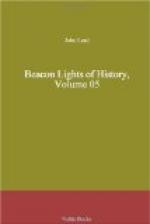The clergy were the friends of order and law, and they were the natural guardians of learning. They were kind masters to the slaves,—for slavery still prevailed. That was an evil with which the clergy did not grapple; they would ameliorate it, but did not seek to remove it. Yet they shielded the unfortunate and the persecuted and the poor; they gave the only consolation which an iron age afforded. The Church was gloomy, ascetic, austere, like the cathedrals of that time. Monks buried themselves in crypts; they sang mournful songs; they saw nothing but poverty and misery, and they came to the relief in a funereal way. But they were not cold and hard and cruel, like baronial lords. Secular lords were rapacious, and ground down the people, and mocked and trampled upon them; but the clergy were hospitable, gentle, and affectionate. They sympathized with the people, from whom they chiefly sprang. They had their vices, but those vices were not half so revolting as those of barons and knights. Intellectually, the clergy were at all times the superiors of these secular lords. They loved the peaceful virtues which were generated in the consecrated convent. The passions of nobles urged them on to perpetual pillage, injustice, and cruelty. The clergy only quarrelled among themselves. Their vices were those of envy, and perhaps of gluttony; but they were not public robbers. They were the best farmers of their times; they cultivated lands, and made them attractive by fruits and flowers. They were generally industrious; every convent was a beehive, in which various kinds of manufactures were produced. The monks aspired even to be artists. They illuminated manuscripts, as well as copied them; they made tapestries and beautiful vestments. They were a peaceful and useful set of men, at this period outside their spiritual functions; they built grand churches; they had fruitful gardens; they were exceedingly hospitable. Every monastery was an inn, as well as a beehive, to which all travellers resorted, and where no pay was exacted. It was a retreat for the unfortunate, which no one dared assail. And it was vocal with songs and anthems.
The clergy were not only thus general benefactors in an age of turbulence and crime, in spite of all their narrowness and spiritual pride and ghostly arts and ambition for power, but they lent a helping hand to the peasantry. The Church was democratic, and enabled the poor to rise according to their merits, while nobles combined to crush them or keep them in an ignoble sphere. In the Church, the son of a murdered peasant could rise according to his deserts; but if he followed a warrior to the battle-field, no virtues, no talents, no bravery could elevate him,—he was still a peasant, a low-born menial. If he entered a monastery, he might pass from office to office until as a mitred abbot he would become the master of ten thousand acres, the counsellor of kings, the equal of that proud baron in whose service his father spent his abject life. The great Hildebrand was the son of a carpenter. The Church ever recognized, what feudality did not,—the claims of man as man; and enabled peasants’ sons, if they had abilities and virtues, to rise to proud positions,—to be the patrons of the learned, the companions of princes, the ministers of kings.




